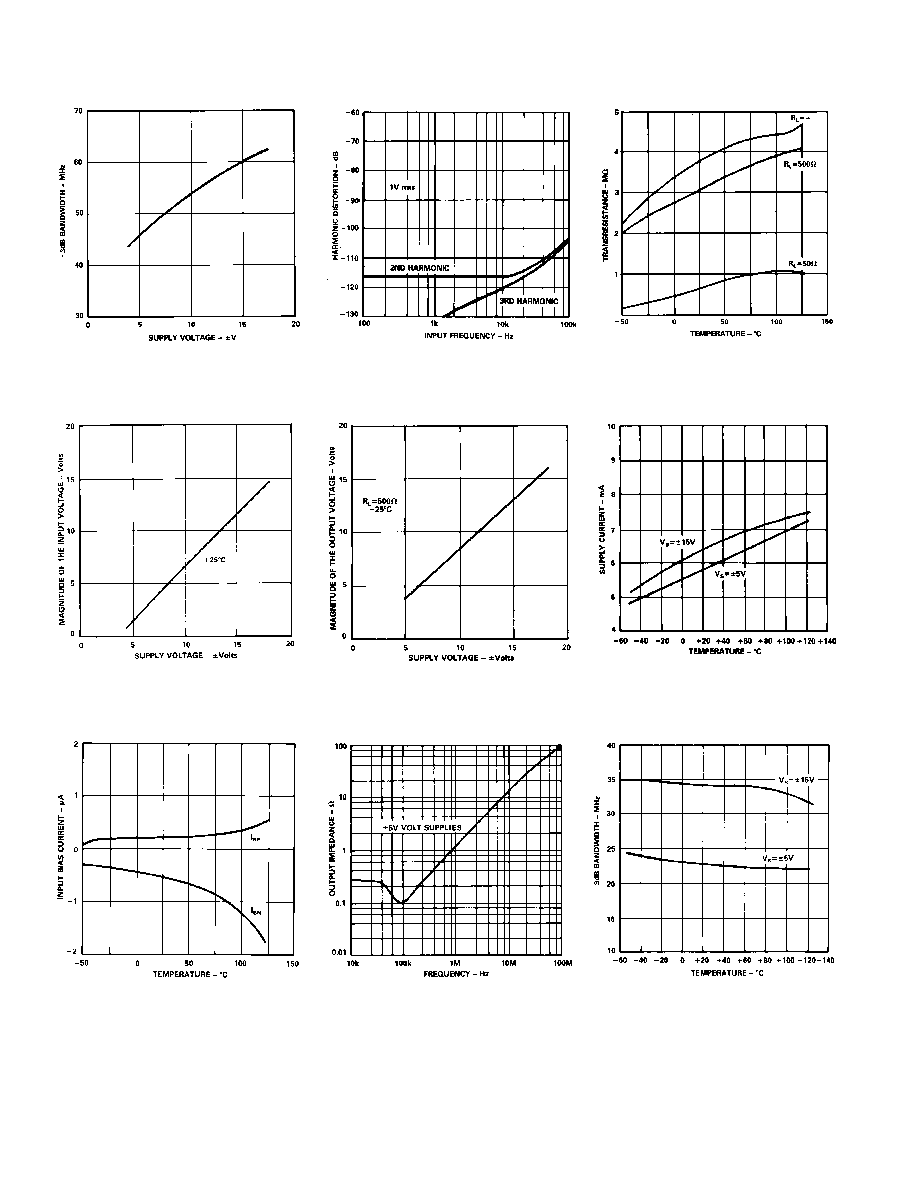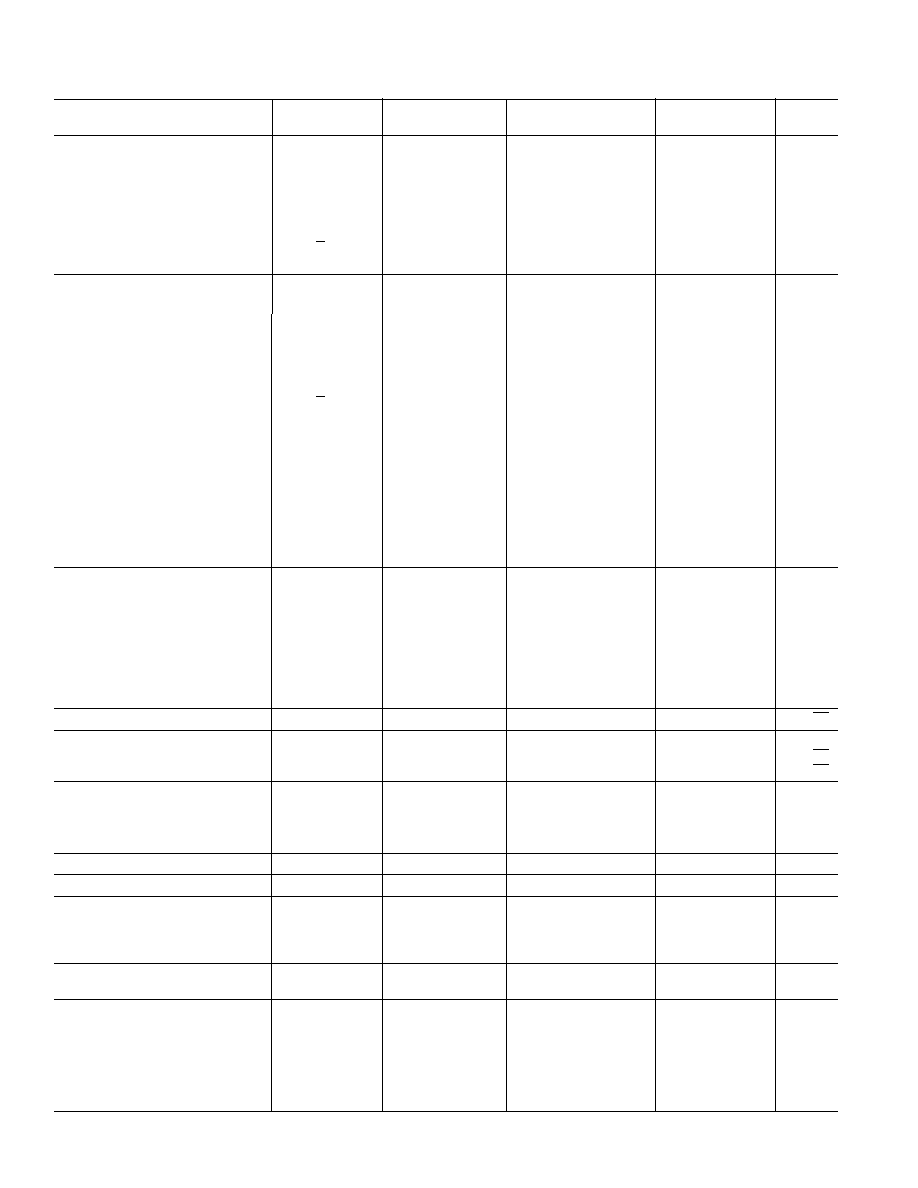
REV. C
Information furnished by Analog Devices is believed to be accurate and
reliable. However, no responsibility is assumed by Analog Devices for its
use, nor for any infringements of patents or other rights of third parties
which may result from its use. No license is granted by implication or
otherwise under any patent or patent rights of Analog Devices.
a
60 MHz, 2000 V/ s
Monolithic Op Amp
AD844
One Technology Way, P.O. Box 9106, Norwood, MA 02062-9106, U.S.A.
Tel: 617/329-4700
Fax: 617/326-8703
CONNECTION DIAGRAMS
FEATURES
Wide Bandwidth: 60 MHz at Gain of ≠1
Wide Bandwidth:
33 MHz at Gain of ≠10
Very High Output Slew Rate: Up to 2000 V/ s
20 MHz Full Power Bandwidth, 20 V pk-pk, R
L
= 500
Fast Settling: 100 ns to 0.1% (10 V Step)
Differential Gain Error: 0.03% at 4.4 MHz
Differential Phase Error: 0.15 at 4.4 MHz
High Output Drive: 50 mA into 50
Load
Low Offset Voltage: 150 V max (B Grade)
Low Quiescent Current: 6.5 mA
Available in Tape and Reel in Accordance with
EIA-481A Standard
APPLICATIONS
Flash ADC Input Amplifiers
High Speed Current DAC Interfaces
Video Buffers and Cable Drivers
Pulse Amplifiers
PRODUCT DESCRIPTION
The AD844 is a high speed monolithic operational amplifier fab-
ricated using Analog Devices' junction isolated complementary
bipolar (CB) process. It combines high bandwidth and very fast
large signal response with excellent dc performance. Although
optimized for use in current to voltage applications and as an
inverting mode amplifier, it is also suitable for use in many non-
inverting applications.
The AD844 can be used in place of traditional op amps, but its
current feedback architecture results in much better ac perfor-
mance, high linearity and an exceptionally clean pulse response.
This type of op amp provides a closed-loop bandwidth which is
determined primarily by the feedback resistor and is almost in-
dependent of the closed-loop gain. The AD844 is free from the
slew rate limitations inherent in traditional op amps and other
current-feedback op amps. Peak output rate of change can be
over 2000 V/
µ
s for a full 20 V output step. Settling time is typi-
cally 100 ns to 0.1%, and essentially independent of gain. The
AD844 can drive 50
loads to
±
2.5 V with low distortion and
is short circuit protected to 80 mA.
The AD844 is available in four performance grades and three
package options. In the 16-pin SOIC (R) package, the AD844J
is specified for the commercial temperature range of 0
∞
C to
+70
∞
C. The AD844A and AD844B are specified for the indus-
trial temperature range of ≠40
∞
C to +85
∞
C and are available in
the cerdip (Q) package. The AD844A is also available in an 8-pin
plastic mini-DIP (N). The AD844S is specified over the military
temperature range of ≠55
∞
C to +125
∞
C. It is available in the
8-pin cerdip (Q) package. "A" and "S" grade chips and devices
processed to MIL-STD-883B, REV. C are also available.
PRODUCT HIGHLIGHTS
1. The AD844 is a versatile, low cost component providing an
excellent combination of ac and dc performance. It may be
used as an alternative to the EL2020 and CLC400/1.
2. It is essentially free from slew rate limitations. Rise and fall
times are essentially independent of output level.
3. The AD844 can be operated from
±
4.5 V to
±
18 V power
supplies and is capable of driving loads down to 50
, as
well as driving very large capacitive loads using an external
network.
4. The offset voltage and input bias currents of the AD844 are
laser trimmed to minimize dc errors; V
OS
drift is typically
1
µ
V/
∞
C and bias current drift is typically 9 nA/
∞
C.
5. The AD844 exhibits excellent differential gain and differen-
tial phase characteristics, making it suitable for a variety of
video applications with bandwidths up to 60 MHz.
6. The AD844 combines low distortion, low noise and low drift
with wide bandwidth, making it outstanding as an input am-
plifier for flash A/D converters.
16-Pin SOIC
(R) Package
8-Pin Plastic (N),
and Cerdip (Q) Packages

AD844J/A
AD844B
AD844S
Model
Conditions
Min
Typ
Max
Min
Typ
Max
Min
Typ
Max
Units
OUTPUT SLEW RATE
Overdriven
Input
1200
2000
1200
2000
1200 2000
V/
µ
s
FULL POWER BANDWIDTH
V
OUT
= 20 V p-p
5
V
S
=
±
15 V
20
20
20
MHz
V
OUT
= 2 V p-p
5
V
S
=
±
5 V
20
20
20
MHz
THD = 3%
OUTPUT CHARACTERISTICS
Voltage
R
LOAD
= 500
10
11
10
11
10
11
±
V
Short Circuit Current
80
80
80
mA
T
MIN
≠T
MAX
60
60
60
mA
Output Resistance
Open Loop
15
15
15
POWER SUPPLY
Operating Range
±
4.5
±
18
±
4.5
±
18
+4.5
±
18
V
Quiescent Current
6.5
7.5
6.5
7.5
6.5
7.5
mA
T
MIN
≠T
MAX
7.5
8.5
7.5
8.5
8.5
9.5
mA
NOTES
1
Rated performance after a 5 minute warmup at T
A
= 25
∞
C.
2
Input signal 285 mV p-p carrier (40 IRE) riding on 0 mV to 642 mV (90 IRE) ramp. R
L
= 100
; R1, R2 = 300
.
3
Input signal 0 dBm, C
L
= 10 pF, R
L
= 500
, R1 = 500
, R2 = 500
in Figure 26.
4
Input signal 0 dBm, C
L
=10 pF, R
L
= 500
, R1 = 500
, R2 = 50
in Figure 26.
5
C
L
= 10 pF, R
L
= 500
, R1 = 1 k
, R2 = 1 k
in Figure 26.
6
C
L
= 10 pF, R
L
= 500
, R1 = 500
, R2 = 50
in Figure 26.
Specifications subject to change without notice. All min and max specifications are guaranteed.
Specifications shown in boldface are tested on all production units at final electrical test.
AD844
REV. C
≠3≠
ABSOLUTE MAXIMUM RATINGS
1
Supply Voltage . . . . . . . . . . . . . . . . . . . . . . . . . . . . . . . . .
±
18 V
Power Dissipation
2
. . . . . . . . . . . . . . . . . . . . . . . . . . . . . 1.1 W
Output Short Circuit Duration . . . . . . . . . . . . . . . . . Indefinite
Common-Mode Input Voltage . . . . . . . . . . . . . . . . . . . . . .
±
V
S
Differential Input Voltage . . . . . . . . . . . . . . . . . . . . . . . . . . 6 V
Inverting Input Current
Continuous . . . . . . . . . . . . . . . . . . . . . . . . . . . . . . . . . 5 mA
Transient . . . . . . . . . . . . . . . . . . . . . . . . . . . . . . . . . . 10 mA
Storage Temperature Range (Q) . . . . . . . . . . ≠65
∞
C to +150
∞
C
Storage Temperature Range
(N, R) . . . . . . . . ≠65
∞
C to +125
∞
C
Lead Temperature Range (Soldering 60 sec) . . . . . . . . +300
∞
C
ESD Rating . . . . . . . . . . . . . . . . . . . . . . . . . . . . . . . . . . 1000 V
NOTES
1
Stresses above those listed under "Absolute Maximum Ratings" may cause
permanent damage to the device at these or any other conditions above those
indicated in the operational sections of this specification is not implied. Exposure
to absolute maximum rating conditions for extended periods may affect device
reliability.
2
28-Pin Plastic Package:
JA
= 100
∞
C/Watt
8-Pin Cerdip Package:
JA
= 110
∞
C/Watt
16-Pin SOIC Package:
JA
= 100
∞
C/Watt
METALIZATION PHOTOGRAPH
Contact factory for latest dimensions.
Dimension shown in inches and (mm).
ORDERING GUIDE
Temperature
Package
Model
Range
Option*
AD844JR
0
∞
C to +70
∞
C
R-16
AD844JR-REEL
0
∞
C to +70
∞
C
Tape and Reel
AD844AN
≠40
∞
C to +85
∞
C
N-8
AD844AQ
≠40
∞
C to +85
∞
C
Q-8
AD844BQ
≠40
∞
C to +85
∞
C
Q-8
AD844SQ
≠55
∞
C to +125
∞
C
Q-8
AD844SQ/883B
≠55
∞
C to +125
∞
C
Q-8
5962-8964401PA
≠55
∞
C to +125
∞
C
Q-8
AD844A Chips
≠40
∞
C to +85
∞
C
Die
AD844S Chips
≠55
∞
C to +125
∞
C
Die
*N = Plastic DIP; Q = Cerdip; R = Small Outline IC (SOIC).

REV. C
≠4≠
(T
A
= +25 C and V
S
= 15 V, unless otherwise noted)
AD844≠Typical Characteristics
Figure 1. ≠3 dB Bandwidth vs.
Supply Voltage R1 = R2 = 500
Figure 4. Noninverting Input Voltage
Swing vs. Supply Voltage
Figure 7. Inverting Input Bias Cur-
rent (I
BN
) and Noninverting Input
Bias Current (I
BP
) vs. Temperature
Figure 2. Harmonic Distortion
vs. Frequency, R1 = R2 = 1 k
Figure 5. Output Voltage Swing
vs. Supply Voltage
Figure 8. Output Impedance vs.
Frequency, Gain = ≠1, R1 = R2 = 1 k
Figure 3. Transresistance
vs. Temperature
Figure 6. Quiescent Supply Current
vs. Temperature and Supply Voltage
Figure 9. ≠3 dB Bandwidth vs.
Temperature, Gain = ≠1,
R1 = R2 = 1 k

AD844
REV. C
≠5≠
Figure 10. Inverting Amplifier,
Gain of ≠1 (R1 = R2)
Figure 12. Phase vs. Frequency
Gain = ≠1, R
L
= 500
, C
L
= 0 pF
Figure 11. Gain vs. Frequency for
Gain = ≠1, R
L
= 500
, C
L
= 0 pF
Figure 13. Large Signal Pulse
Response, Gain = ≠1, R1 = R2 = 1 k
Figure 14. Small Signal Pulse
Response, Gain = ≠1, R1 = R2 = 1 k
Inverting Gain of 1 AC Characteristics
Inverting Gain of 10 AC Characteristics
Figure 17. Phase vs. Frequency,
Gain = ≠10
Figure 16. Gain vs. Frequency,
Gain = ≠10
Figure 15. Gain of ≠10 Amplifier




